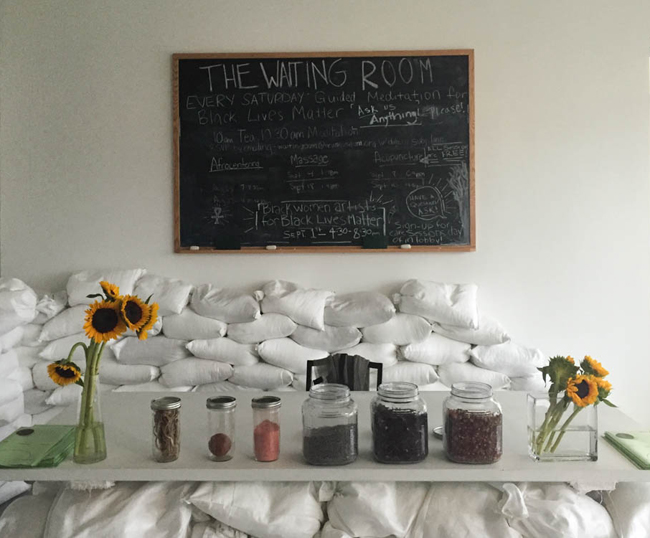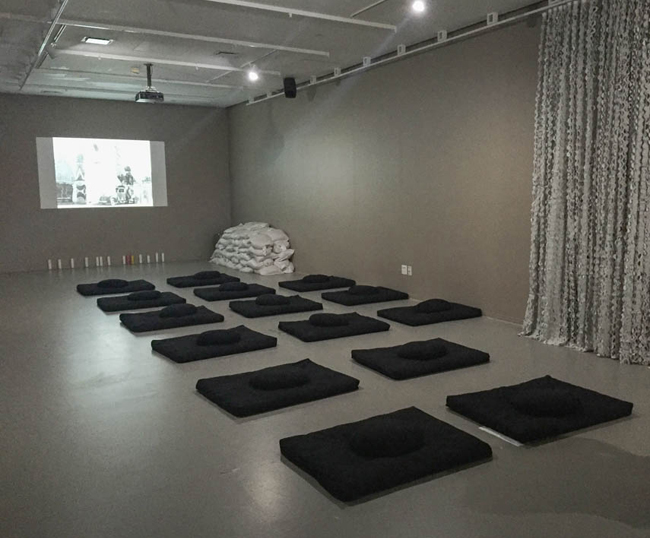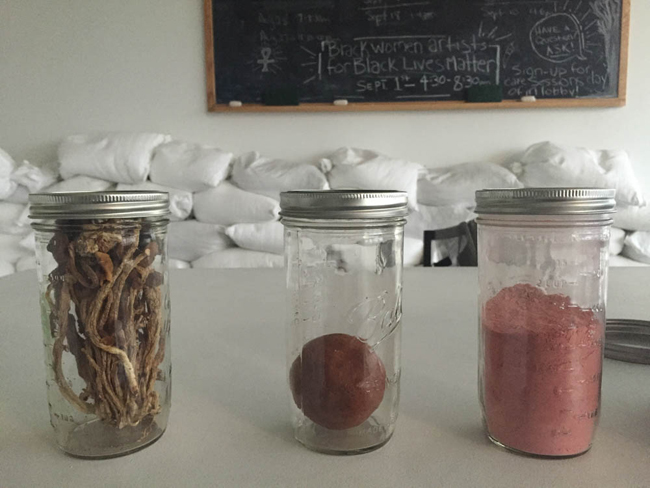Simone Leigh’s Waiting Room
Erin Sweeny
December 2016
 Installation View, Simone Leigh: The Waiting Room, New Museum, 2016. Image courtesy of the author
Installation View, Simone Leigh: The Waiting Room, New Museum, 2016. Image courtesy of the author
A Revolution of Self-Care in Simone Leigh’s Waiting Room
This summer I discovered my first gallery-cum-movement studio, located on the Fifth Floor of the New Museum. I’d gone to check out a Thursday evening Afrocentering class as part of Care Sessions—a three-month program led by holistic health practitioners as part of artist Simone Leigh’s installation, The Waiting Room. Gathered with a group of men and women in the main gallery, we turned our attention towards Aimee Meredith Cox—a former member of the Alvin Ailey Repertory Ensemble and our dance teacher for the night.
Over the course of the summer, Leigh’s installation and programming expanded an ongoing exploration of black female subjectivities, in this case exposing related injustices of the healthcare system while also shedding light on the transformative potential of holistic care. An introductory essay for The Waiting Room began with the story of Esmin Green, a forty-nine-year-old woman and Jamaican native from Brooklyn who waited for nearly twenty-four hours to receive treatment after being admitted to the emergency room at Kings County Hospital Center. Green subsequently collapsed in the waiting room, still left unattended on the floor for over an hour as she died.
How do you take care of yourself?
The heartbreaking reality of Esmin Green’s story offered a grim introduction to the exhibition, ultimately serving as a gateway for references to community-organized care as a radical act of resistance. Leigh referenced historical examples such as the United Order of Tents (a secret society of nurses active since the Underground Railroad) and health clinics run by the Black Panther Party from the 1960s to the 1980s, citing revolutionary efforts to battle indifference and address urgent needs of the black community. Rightly focused on the ongoing struggle for women of color, the exhibition also ignited a larger conversation around the notion of wellness and how each one of us—regardless of gender, race or class—responds to questions about self and social care in the present.
What do you care about?
The programming schedule for The Waiting Room defined Afrocentering as “a movement philosophy created by Aimee Meredith Cox that focuses on mind-body connection and self-awareness.” Cryptic. Not knowing what to expect, I showed up with pants I could move in and an open mind. Milling around the temporary apothecary installed next door, I noticed a chalkboard listing other care sessions featuring massage, acupuncture, herbalism and meditation. A video monitor in the gallery screened documentary footage from Free People’s Medical Clinic, Leigh’s 2014 project (housed in the former Bedford-Stuyvesant, Brooklyn home of Dr. Josephine English, the first black OB-GYN in the state of New York) also centered around community health offerings.
 Installation View, Simone Leigh: The Waiting Room, New Museum, 2016. Image courtesy of the author
Installation View, Simone Leigh: The Waiting Room, New Museum, 2016. Image courtesy of the author
Gathering participants together, Cox sat us down in a circle and posed these two questions to the group as a sort of introduction to the session: How do you take care of yourself? What do you care about? Their simple yet direct nature caught me by surprise, as did the answers shared amongst strangers in our first minutes together. Admittedly, I’d been skeptical of how these classes would work in a gallery setting. In contrast to Free People’s Medical Clinic, situated in a historic location with public access for the Bed-Stuy community, I questioned whether the conceptual framework of holistic care sessions could provide meaningful experiences for museum visitors tucked away on one of its upper floors.
In a group numbering around twenty, there were men and women of various races and ages, locals mixed with tourists visiting from around the globe. The woman next to me spoke of swimming in the sea as a type of self-care. Another man mentioned long walks in the city to clear his mind (my head nodding in agreement). Some admitted that caring for others took precedence. I talked of breathing deeply and making space. Our answers may have been timid, but they were earnest. Cox, a dancer who is also a cultural anthropologist and tenured professor of African and African American Studies at Fordham University, talked more about her own role as a practitioner and advocate empowering young black women. In a gallery bordered by symbolic rows of white sandbags, she emphasized the revolutionary potential of self and community care.
During the hour that followed, there was movement. A lot of movement. As we danced, museum visitors continued to move through and watch our group from the sides of the gallery. At times, I lost the sequence of steps and felt like a ball of swinging limbs on display. But I followed Cox’s advice, continuing to move and make it up until I could pick up the flow again. And in the solidarity of that flow, I felt both disarmed and strengthened. It is a simple metaphor. But in the context of Leigh’s exhibition and the contrast of my own subjectivity as a white woman, it also felt symbolic of my own struggle to better understand the interconnected systems of social inequities that we all are a part of.
In The Waiting Room, Simone Leigh created a valuable space for contemplation paired with a unique opportunity to engage directly with practitioners. Transcending its facade and temporal nature, the environment felt honestly geared towards wellness. Furthermore, the gallery setting and the New Museum’s educational programming grounded these care sessions in a history of holistic care rooted in urgency and conflict rather than luxury and comfort. Leigh continues to educate us in her struggle for increased dialogue and justice, also presenting true alternatives and access in response.
Returning once again to the questions posed by Aimee Meredith Cox, I now consider them a deceivingly simple mantra. How do you take care of yourself? What do you care about? In these final days of 2016, they take on additional significance as we recalibrate in anticipation of the year ahead. We are living in turbulent times, marked by the ugliest presidential election I have witnessed in my lifetime and heartbreaking reminders of the social and racial inequities that continue to divide us. Many are, in a sense, still in The Waiting Room—waiting to see what happens after Donald Trump’s inauguration, waiting for the other shoe to drop, waiting to see if they’ll still have healthcare, waiting. The overarching theme of Simone Leigh’s exhibition ultimately translates as a call to action by posing the most important question of our time:
What are we waiting for?
 Installation View, Simone Leigh: The Waiting Room, New Museum, 2016. Image courtesy of the author
Installation View, Simone Leigh: The Waiting Room, New Museum, 2016. Image courtesy of the author
